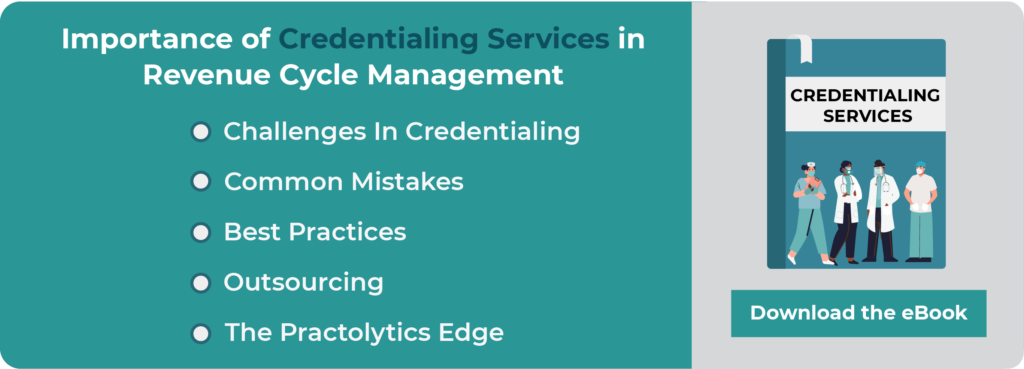Finding Success: Credentialing Essentials for Radiology Practices
Master radiology credentialing with essential strategies for success. Learn key steps, compliance requirements, and best practices to streamline the process, reduce delays, and ensure provider eligibility. Optimize reimbursements and maintain regulatory compliance with expert insights on navigating credentialing challenges in the ever-evolving healthcare landscape.
Credentialing in radiology practices is a meticulous process that involves verifying the qualifications, experience, and competency of healthcare providers and facilities to deliver radiological services. This comprehensive assessment evaluates various aspects such as education, training, licensure, certifications, and professional background of radiologists, radiologic technologists, and other personnel involved in providing radiology services. Its primary purpose is to ensure that healthcare providers meet the necessary standards and requirements established by regulatory bodies, accreditation organizations, and insurance payers to practice and receive reimbursement for radiological services.
Effective credentialing is paramount for the success of radiology practices on multiple fronts. Firstly, it enables practices to gain access to payer networks, participate in insurance plans, and secure reimbursement for the services they offer. Additionally, robust credentialing builds trust and confidence among patients and referring physicians by showcasing the qualifications and competence of healthcare providers and facilities. Furthermore, it ensures compliance with regulatory mandates and accreditation standards, thereby minimizing the risk of legal liabilities and sanctions. Moreover, proper credentialing streamlines administrative processes, facilitates timely reimbursement, and ultimately contributes to the financial sustainability and overall success of radiology practices.
Table of Contents
Understanding Credentialing in Radiology
Credentialing in radiology encompasses a series of processes aimed at verifying the qualifications, competencies, and credentials of healthcare providers and facilities involved in delivering radiological services. Its primary purpose is to ensure that healthcare professionals meet the necessary standards and requirements established by regulatory bodies, accreditation organizations, and insurance payers to practice and receive reimbursement for radiology services.
There are two main types of credentialing in radiology: provider credentialing and facility credentialing. Provider credentialing focuses on evaluating the qualifications, licensure, certifications, and professional background of individual radiologists, radiologic technologists, and other personnel directly involved in delivering radiological services. Facility credentialing, on the other hand, involves assessing the infrastructure, equipment, policies, procedures, and quality assurance measures of radiology facilities to ensure compliance with regulatory and accreditation standards.
Credentialing requirements and standards in radiology vary depending on the jurisdiction, healthcare setting, and type of radiological services offered. However, common elements include verifying education and training credentials, confirming licensure and certifications, assessing clinical competence, conducting background checks, and ensuring compliance with ethical and professional standards. These requirements aim to uphold patient safety, maintain quality of care, and promote transparency and accountability in radiology practice.
The Impact of Credentialing on Practice Success
Ensuring Access to Payer Networks: Effective credentialing enables radiology practices to participate in insurance payer networks, allowing them to provide services covered by health plans. Being credentialed with insurance companies ensures that patients have access to radiological services without facing significant out-of-pocket expenses, thereby expanding the practice’s patient base and revenue potential.
Building Trust and Credibility: Credentialing instills confidence in patients and referring physicians by validating the qualifications and expertise of radiologists and the quality of services offered by the practice. Being credentialed demonstrates adherence to industry standards and best practices, fostering trust and loyalty among stakeholders and enhancing the practice’s reputation in the healthcare community.
Facilitating Timely Reimbursement: Proper credentialing streamlines the reimbursement process by ensuring that claims are submitted accurately and promptly to insurance payers. Credentialed practices are more likely to receive timely payments for services rendered, reducing the risk of revenue cycle disruptions and cash flow issues. Timely reimbursement contributes to financial stability and allows practices to reinvest in resources and infrastructure to enhance patient care.
Mitigating Compliance Risks: Credentialing helps radiology practices adhere to regulatory requirements and industry guidelines, minimizing the risk of compliance violations and legal liabilities. By ensuring that providers and facilities meet licensure, accreditation, and quality standards, credentialing helps protect against potential legal challenges, audits, and penalties. Compliance with credentialing requirements also promotes patient safety and ensures ethical conduct in radiology practice.
Key Steps in the Credentialing Process
Gathering Necessary Documentation and Information: The credentialing process begins with collecting all required documentation and information, including licenses, certifications, malpractice insurance, education credentials, work history, and professional references. These documents serve as evidence of the provider’s qualifications and competence in radiology practice.
Completing and Submitting Credentialing Applications: Once the necessary documentation is gathered, providers must complete credentialing applications required by credentialing organizations and insurance payers. These applications typically include detailed information about the provider’s background, training, experience, and practice affiliations. Completing and submitting accurate and comprehensive applications is crucial for a successful credentialing process.
Following Up with Credentialing Organizations and Payers: After submitting credentialing applications, providers should proactively follow up with credentialing organizations and insurance payers to ensure the timely processing of their applications. This may involve communicating with credentialing coordinators, providing additional information or clarification as needed, and monitoring the progress of the credentialing review process.
Monitoring Credentialing Status and Renewals: Once credentialed, providers must monitor their credentialing status regularly and ensure timely renewals to maintain active status with credentialing organizations and insurance payers. This involves staying informed about renewal deadlines, updating credentials and documentation as necessary, and addressing any changes in practice affiliations or contact information promptly.
Challenges and Pitfalls in Radiology Credentialing
Complexities of Credentialing Requirements and Paperwork: The credentialing process involves extensive paperwork and documentation, which can be complex and time-consuming to gather and complete. Providers must navigate various credentialing requirements and standards set by credentialing organizations and insurance payers, adding to the complexity of the process.
Delays in Credentialing Approval and Network Participation: Credentialing approval and network participation can be subject to significant delays, leading to disruptions in practice operations and revenue generation. Providers may experience delays in processing credentialing applications, receiving network participation approvals, and obtaining reimbursement from insurance payers, impacting practice sustainability and financial stability.
Maintaining Credentialing Compliance and Avoiding Lapses: Once credentialed, providers must remain vigilant in maintaining credentialing compliance and avoiding lapses in credentialing status. This requires ongoing monitoring of credentialing status, timely renewal of credentials, and adherence to credentialing requirements and standards to ensure continuous participation in insurance payer networks.
Addressing Credentialing Denials and Appeals: Credentialing denials and appeals can pose significant challenges for radiology practices, requiring providers to navigate complex appeals processes and address issues that led to credentialing denials. Providers may need to submit additional documentation, provide clarification on credentialing applications, or appeal credentialing decisions to overturn denials and gain access to insurance payer networks.
Strategies for Successful Radiology Credentialing
Establishing an Organized Credentialing Process: Radiology practices should establish a systematic and organized credentialing process to manage credentialing tasks efficiently. This involves creating clear workflows, assigning responsibilities to team members, and setting timelines for completing credentialing applications and documentation.
Utilizing Credentialing Software and Tools: Leveraging credentialing software and tools can streamline the credentialing process and enhance efficiency. These software solutions often offer features such as document management, application tracking, and reminders for credentialing deadlines, enabling practices to stay organized and proactive in their credentialing efforts.
Partnering with Experienced Credentialing Specialists or Services: Engaging experienced credentialing specialists or services can provide valuable expertise and support in navigating the credentialing process. These specialists understand the intricacies of radiology credentialing requirements and can help practices prepare thorough applications, address credentialing challenges, and advocate for timely approval and network participation.
Maintaining Open Communication with Payers and Credentialing Organizations: Establishing open communication channels with insurance payers and credentialing organizations is essential for addressing credentialing-related issues and inquiries promptly. Practices should maintain regular contact with payer representatives, seek clarification on credentialing requirements, and proactively address any concerns or discrepancies in credentialing applications.
Final Words
Credentialing process involves a meticulous process of verifying the qualifications, experience, and competency of healthcare providers and facilities to deliver radiological services. Effective credentialing ensures access to payer networks, builds trust with patients and referring physicians, facilitates timely reimbursement, and mitigates compliance risks.
ALSO READ – Securing Healthcare Excellence: The Crucial Role of Medical Credentialing
Talk to Medical Billing Expert Today — Get a Free Demo Now!






